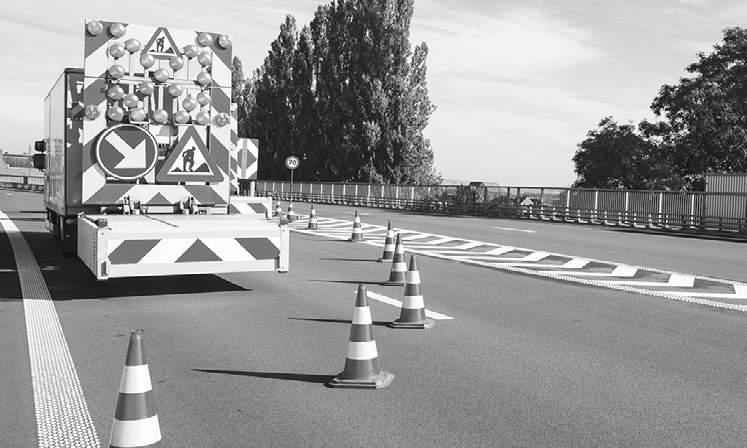
4 minute read
NEW TECHNOLOGY IMPROVES ASPHALT ROAD CONSTRUCTION
Autonomous Attenuator Vehicles Keep Highway Workers Out of Harm’s Way in Work Zones
By Lucy Perry CEG CORRESPONDENT
The asphalt pavements we drive on daily are the result of decades of blood, sweat and tears, both in the field and in the lab. Experimentation with new and different materials; trial and error developing better, safer construction machinery; and the risks taken to put the finishing touches never stop.
What’s new in asphalt road construction, machinery and safety? Developed over years, porous pavement design, perpetual pavement and autonomous vehicles are all making headlines today as technology meets demand.
Splash-Free Driving
Permeable pavement, including porous types, is one of the fastest growing technologies in sustainable asphalt roadway engineering.
Developed chiefly for safety advantages, porous pavement reduces splash and spray. Darlene Goehl of the Texas Transportation Institute’s materials and pavements division believes the design also improves improve visibility for drivers.
“It helps avoid the hydroplaning problems you may see in wet weather,’ Goehl said in a podcast interview. “It’s actually a porous friction course.”
Impervious surfaces are often the causes of stormwater runoff, according to paving information provider PavingFinder.
“Porous asphalt pavement is a specialized mixture comprised of both fine and course aggregates bound together by a bituminous binder. The surface appearance of porous asphalt is similar to traditional asphalt, but it has a rougher texture.”
The material is placed over a granular working platform on top of a lare stone reservoir, and the surface is made porous by building with open-graded friction coarse aggregate.
“The layer under the porous asphalt has the storage capacity to hold the collected water,” explained PavingFinder.
Highway engineers pour the material in a thin surface layer on conventional pavement. Rainwater sinks into the pavement surface and settles on an impermeable asphalt layer below.
“Water is forced to drain off the side of the highway,” according to the organization. “Even in a driving rainstorm, splash and spray from trucks is absorbed into the pavement.”
Visibility for drivers improves to the degree that crashes and fatalities can be “significantly” reduced, believes PavingFinder.
Recent developments in stormwater ordinances across the country have begun to require more significant onsite stormwater infiltration and detention.
And, according to the paving information organization, a primary incentive for using permeable pavement is to add a hydrological benefit to a roadway or site design.
“Permeable pavement can reduce the concentration of pollutants by trapping them physically, chemically or biologically.”
State departments of transportation believe autonomous vehicles, dubbed Autonomous Truck-Mounted Attenuators (ATMA), will improve safety in work zones by removing the driver from the impact protection vehicle during normal operation.
Autonomous attenuator vehicles take the driver out of harm’s way while still effectively shielding roadside workers.

designed to last 50 years or longer without any repairs below the wearing course or surface level.
The pavement typically has a multi-layered structure which resists fatigue over time, according to the Asphalt Pavement Alliance.
Ralph Isenberg, director of governmental affairs for Reliable Paving, outlined in a blog post an APA research paper on the technology.
The triple-layered structure resists structural damage for as long as the top surface is maintained and replaced.
“While the outer surface is cared for, the rest of the pavement will not to be fully repaired or replaced for many years.”
The goal of perpetual pavement is to be a deep-strength asphalt paving that resists fatigue. It does so by reducing cracking from the bottom-up, said APA.
“When pavements undergo road traffic, fatigue develops from the cyclical nature and weight of the traffic. The fatigue begins as cracks at the pavement foundation. These foundational cracks then work their way up to the higher layers of pavement.”
As they infiltrate the pavement layers, cracks spread out and multiply. Over time the cracks present on the surface of the asphalt pavement.
“Perpetual pavement is designed specifically to resist bottom-up fatigue cracking and structural rutting,” said APA.
These two types of damage are among the worst asphalt pavement can receive. Superior to low-grade pavement exhibits rutting and cracking before their design-life is achieved.
Whereas superior to high-grade traditional pavement proves it uses materials more efficiently.
The pavement also reduces cyclical costs. “As long-term damage is avoided, yearly or multi-yearly-accrued damage doesn’t need to be repaired,” reported APA.
Because the design is more efficient, sections of overly thick asphalt are eliminated. Reconstruction costs are eliminated, as well.
Plus, delays due to maintenance occur less and as a result, maintenance costs drop. Perpetual pavement also reduces the need for non-renewable asphalts and aggregates.
Driverless Vehicles
Goehl of the Texas Transportation Institute said autonomous vehicles will change the way asphalt pavements are constructed. Today’s 12-ft. wide driving lanes will look different in the future.
“If you look at that path where people normally drive, it tends to be on each tire about three foot wide. So, there’s some wander when you drive just naturally within the lane, that kind of distributes the weight of that car over half the lane. So about six-foot total,” she said.
But designers are anticipating changes in road pavement spread to accommodate autonomous vehicle technology, said Goehl.
“When you go to a self-driving car, they’re going to drive in a path similar to a train on a track. Now instead of that tire meandering over a three-foot area, it’s prob-









